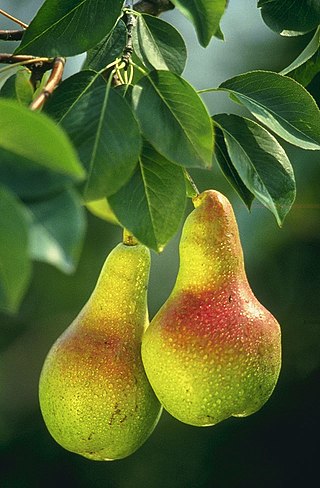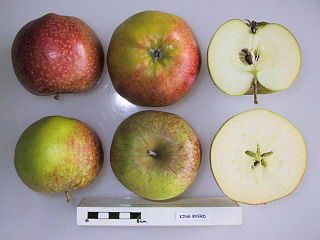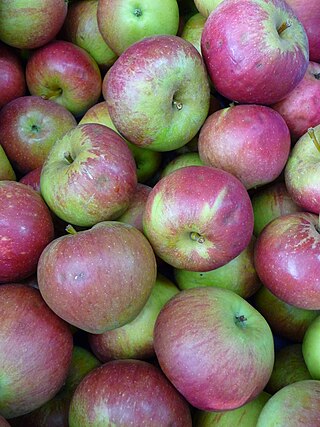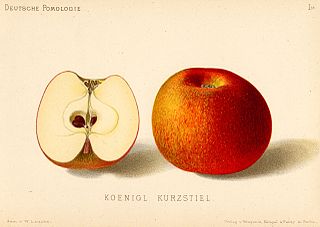
Pears are fruits produced and consumed around the world, growing on a tree and harvested in late summer into mid-autumn. The pear tree and shrub are a species of genus Pyrus, in the family Rosaceae, bearing the pomaceous fruit of the same name. Several species of pears are valued for their edible fruit and juices, while others are cultivated as trees.
Perry is an alcoholic beverage made from fermented pears, traditionally in England, particularly Gloucestershire, Herefordshire, and Worcestershire, parts of South Wales and France, especially Normandy and Anjou, Canada, Australia and New Zealand.

A lenticel is a porous tissue consisting of cells with large intercellular spaces in the periderm of the secondarily thickened organs and the bark of woody stems and roots of gymnosperms and dicotyledonous flowering plants. It functions as a pore, providing a pathway for the direct exchange of gases between the internal tissues and atmosphere through the bark, which is otherwise impermeable to gases. The name lenticel, pronounced with an, derives from its lenticular (lens-like) shape. The shape of lenticels is one of the characteristics used for tree identification.

Pyrus pyrifolia is a species of pear tree native to East Asia. The tree's edible fruit is known by many names, including: Asian pear, Persian pear, Japanese pear, Chinese pear, Korean pear, Taiwanese pear, apple pear, zodiac pear, three-halves pear, papple, naspati and sand pear. Along with cultivars of P. × bretschneideri and P. ussuriensis, the fruit is also called the nashi pear. Cultivars derived from Pyrus pyrifolia are grown throughout East Asia, and in other countries such as India, Nepal, Australia, New Zealand, and the United States. Traditionally in East Asia the tree's flowers are a popular symbol of early spring, and it is a common sight in gardens and the countryside.

Red Delicious is a type of apple with a red exterior and sweet taste that was first recognized in Madison County, Iowa, in 1872. Today, the name Red Delicious comprises more than 50 cultivars. It was the most produced cultivar in the United States from 1968 to 2018, when it was surpassed by Gala.

The Beurre Bosc or Bosc is a cultivar of the European pear, originally from France or Belgium. Also known as the Kaiser, it is grown in Europe, Australia, British Columbia and Ontario, Canada, and the northwestern U.S. states of California, Washington, and Oregon.

Venturia inaequalis is an ascomycete fungus that causes the apple scab disease.

The Mutsu apple was introduced in 1949 and is a cross between the 'Golden Delicious' and the 'Indo' apple cultivars first grown in Aomori Prefecture, Japan. The apple's name is the former name of a large section of the Tōhoku region, Mutsu Province, which Aomori was created from during the Meiji Restoration.

'Ribston Pippin' is a triploid cultivar of apples, also known by other names including 'Essex Pippin', 'Beautiful Pippin', 'Formosa', 'Glory of York', 'Ribstone', 'Rockhill's Russet', 'Travers', and 'Travers's Reinette'.

A pearmain, also formerly spelled "permain", is a type of apple. The name may once have been applied to a particular variety of apple that kept well, although in more modern times its inclusion in varietal names was, like the term 'Pippin', "largely decoration" rather than indicating any shared qualities.

Podosphaera leucotricha is a plant pathogen that can cause powdery mildew of apples and pears.

Bitter pit is a disorder in apple fruits, now believed to be induced by calcium deficiency. It occurs less commonly in pears.

An apple is a round, edible fruit produced by an apple tree. Apple trees are cultivated worldwide and are the most widely grown species in the genus Malus. The tree originated in Central Asia, where its wild ancestor, Malus sieversii, is still found. Apples have been grown for thousands of years in Asia and Europe and were introduced to North America by European colonists. Apples have religious and mythological significance in many cultures, including Norse, Greek, and European Christian tradition.

The King Byerd is a cultivar of domesticated apple, that originated in Cornwall. It is primarily used for cooking.

Fiesta is a modern cultivar of domesticated apple which is often marketed as Red Pippin. It was developed in the United Kingdom by breeders at the East Malling Research Station, combining the Cox's Orange Pippin with the Idared apple. According to the Orange Pippin website, it is one of the best Cox's style apples, but much easier to grow having good disease resistance.

'Delbard Jubilée' or 'Delgollune' is a modern French cultivar of domesticated apple which was developed in 1964 by Delbard nurseries. It is not the same as the Jubilee apple that was developed in Canada.

Golden Russet is an old American cultivar of domesticated apple which is excellent for fresh eating as well as for apple cider production. It is a russet apple and is therefore especially used as a cider apple. It is sometimes known as 'English Golden Russet', and has frequently been confused with 'English Russet'.

Court Pendu Plat is an extremely old French cultivar of domesticated apple that was first recorded in 1613. The cultivar definitely dates back to earlier than the 17th century, and was probably cultivated by the Romans. It is known for its intense flavor which mellows with storage.
The Churchland or Church is a cultivar of the European pear, it was developed in New Rochelle, New York in northeastern United States. It is believed to have originated as a seedling raised by one of the early Huguenot settlers of the village in the late 17th century. The original tree stood on land which was owned by the Trinity St. Paul's Church of New Rochelle, hence the naming of the fruit "Church". The fruit was so luscious that it was universally liked and, by grafting, the tree soon had extensive propagation throughout the country. An early account of the tree appeared in the proceedings of the American Pomological Society in 1856.
The Parsonage is a cultivar of the European Pear which is a native of New Rochelle, New York in northeastern United States. The pear tree, found on the parsonage of Reverend Doctor R. U. Morgan, rector of Trinity Episcopal Church, was introduced as the Parsonage pear in 1857 by Stephen P. Carpenter of the Huguenot Nurseries of New Rochelle. The original tree was a constant and abundant bearer of fruit which was viewed as flavorful and of very good quality.



















